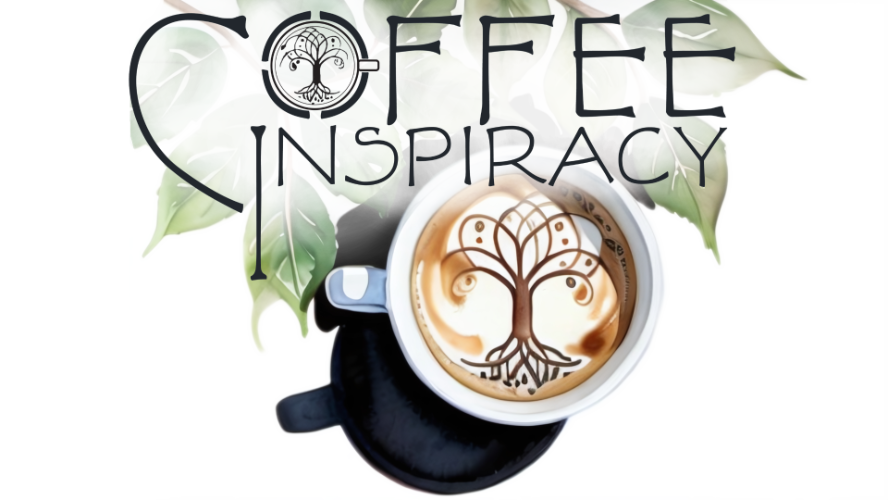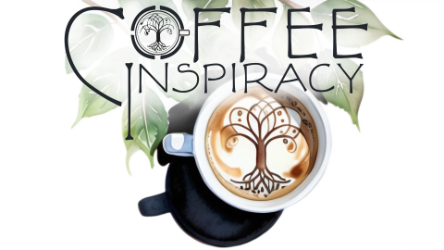Inner Peace
Joy
and
Really Good Coffee
The one within that seeks is the One that you are seeking.
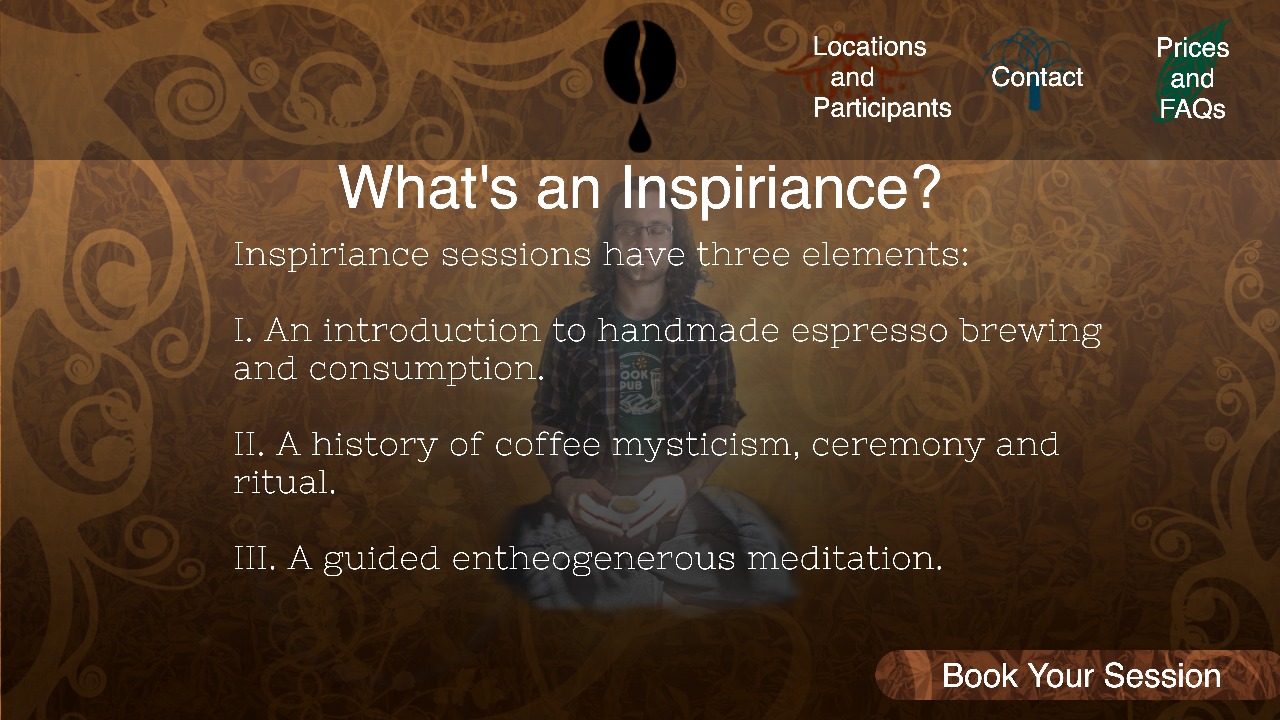


What is Coffee Inspiracy?
Our primary offering fuses history, beautiful espresso and meditation in a two-hour session called an “Inspiriance”. You can learn more about the Inspiriance at the bottom of this page and also on our booking page.

Who is Coffee Inspiracy?
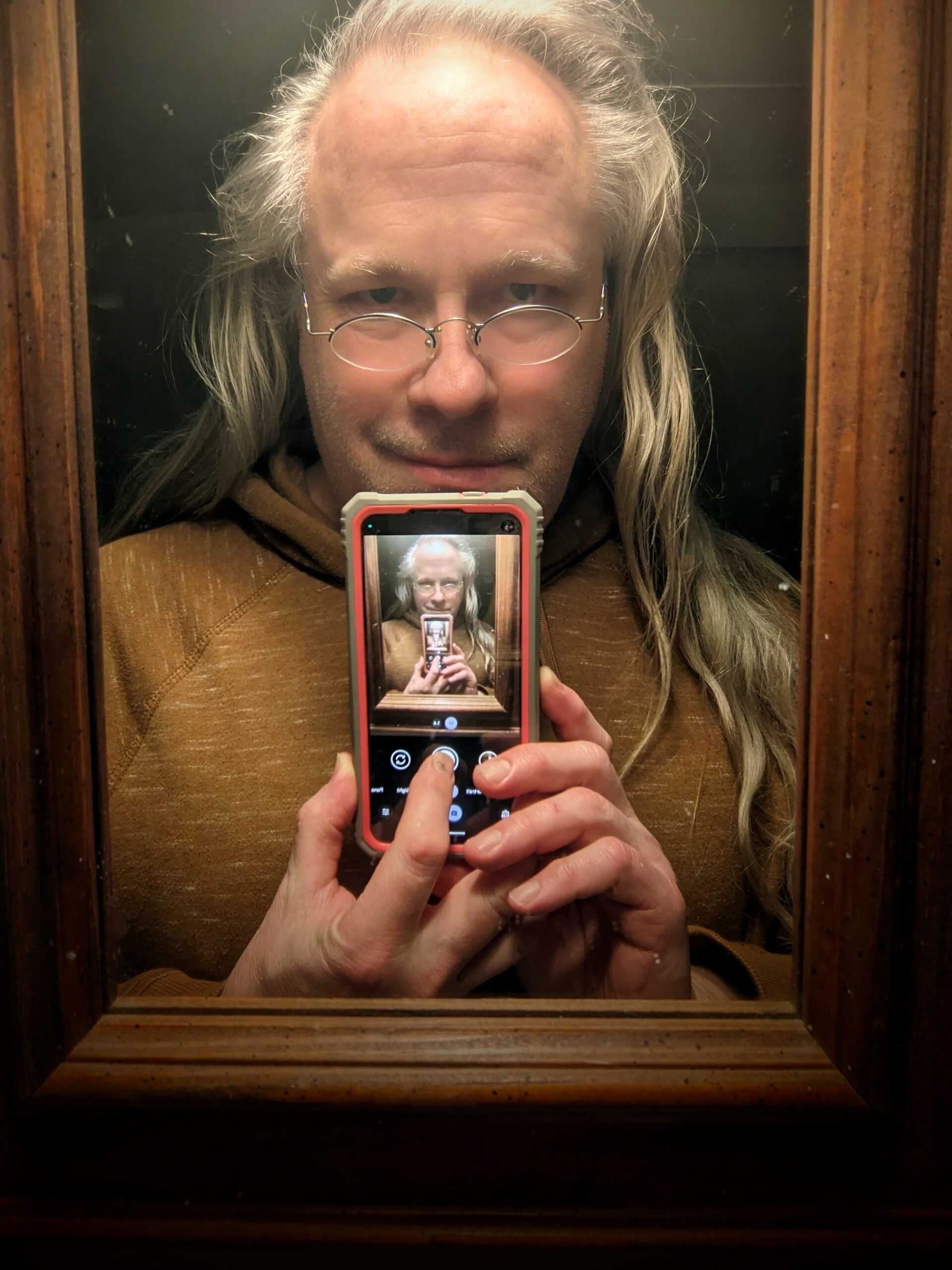
Where is Coffee
Inspiracy?

Why Are You
Doing this?
Thus, the products of this alliance, while profound, are nonetheless unbalanced.
By returning our awareness to the roots of our coffee alliance, Coffee Inspiracy seeks to bring its outcomes into alignment with the peace and joy that is the divine nature at the heart of our being.
If you want to learn more, take a deep dive below.



What is
Coffee Inspiracy?
Our primary offering fuses history, beautiful espresso and meditation in a two-hour session called an “Inspiriance”. You can learn more about the Inspiriance at the bottom of this page and also on our booking page.

Who is
Coffee Inspiracy?

Where is Coffee
Inspiracy?

Why Are You
Doing this?
Thus, the products of this alliance, while profound, are nonetheless unbalanced.
By returning our awareness to the roots of our coffee alliance, Coffee Inspiracy seeks to bring its outcomes into alignment with the peace and joy that is the divine nature at the heart of our being.
If you want to learn more, take a deep dive below.
Inspiriance is the best teacher
It was beautiful.

A true deep dive. The guided meditation has shed some new light on my own practice and I am going to be reflecting on that light well into the future.

It was very healing. I'm excited to share this with more people. I want to share the consciousness that is everything.
It was truly incredible. I really don't think most people understand the power of caffeine/coffee as a launching pad to peace - I def did not.

Effing brilliant!

Peter MooreBreitenbush Hot Springs

We get it. It's radical. It's new. And it challenges our narratives about a drink that is entwined with our culture.
So, let us make our case. We've sown the panels below with the seeds of stories and ideas to inspire you and help grow your understanding.
Of course, words can only take you so far. When you're ready to dig deeper, coffee is ready to help.
Book your session today
and transform
your coffee experience

We get it. It's radical. It's new. And it challenges our narratives about a drink that is entwined with our culture.
So, let us make our case. We've sown the panels below with the seeds of stories and ideas to inspire you and help grow your understanding.
Of course, words can only take you so far. When you're ready to dig deeper,
coffee is ready to help.
Book your session today
and transform
your coffee experience
Heads up!
You're scrolling into
the Deep Dive.


Grounding
First, as you can tell already, there are many words here. We have a lot of assumption busting to do, and that's just gonna take some storytelling.
This site is optimized for Chrome, though most modern browsers should work fine.
Clicking on the main heading icons (roots, branches, leaf, bean) will always lead to one of these narratives, or back to the top.
Use the right hand navigation arrow to move forward through this story.
Coffee Inspiracy brought the receipts. Click the quote icons for attributions and links to further study.

Grounding
Our offerings are authentic expressions of our own experiences, sourced from and for this culture, this place, this moment.
Get Inspired. The drink is more than you think.

Grounding
There is a lot to know about coffee.
In the lands to the south of ancient Abyssinia (now Ethiopia), in the shadow of the Boma Plateau, the literal birthplace of Cafea Arabica, members of the Oromo tribe tell this story of the birth of coffee:
"The supreme being Waaqa once had to punish one of his loyal servants for a crime. The punishment was death. After the sentence was passed, Waaqa found out that the man was innocent. Unfortunately, it was too late to save him because the sentence had already been carried out, and the man was dead. Filled with grief, Waaqa visited the man’s grave and wept. As the tears from Waaqa’s eyes watered the ground, a new plant sprung up from the ground – coffee."
“The role of coffee in rituals is rather eloquent among the Jimma Oromo...coffee is not just a beverage to be shared with neighbors but a means to daily supplicate and thank God (Waaqa). Traditional Oromo coffee ceremonies are often accompanied by the burning of incense and interspersing a very small portion of the meal to be served before drinking the first round coffee. "
"Coffee’s role in rituals is more pronounced in such trying times as agricultural failure, epidemic, drought and damaging rains. During these occasions, coffee can be prepared at home, within compounds, under shade of a tree or within a mosque compound where people gather and attend communal prayers aimed at pleading Waaqa for good harvest, the well-being of the people and nurturing rains. The overall purpose of coffee in Oromo rituals is to serve as a medium of appealing Waaqa to reverse difficult conditions and gratify Him for euphoric events. In this context, coffee can irrefutably be considered as a sacred plant employed as a ritual means to maintain the social order with the divine."
"The use of coffee in Oromo rituals gets a further impetus in bunä-qäla (coffee slaughtering) ritual, [observed] during such occasions as the atete ceremony (a female ritual invoked for the health and fertility of the woman), naming of a newly born child, and sacrifice for a deceased person. The bunä-qäla ritual survives in two important cultural realms of the Jimma Oromo in Gomma: the birth of a calf and the arrangement of marriage. In this context, it is a means of prayer and praising Waaqa."
"Since it is the female who slaughters coffee, the ritual is intertwined with diverse sexual metaphors representing woman, symbolizing human fertility, but also of cattle and sheep as well as the bursting open of seeds in plants. These uses of coffee in Oromo feasts and rituals as a substitute for blood would situate the plant between two extremes, the animal and the vegetable realms."
Sometime in the mid 1400's, an aspiring Yemeni Sufi named Mohammed bin Sa’id, a.k.a. al-Dhabhani, witnessed the Oromo using coffee while traveling in Abyssinia. His experience inspired him to bring some coffee back to his home in Aden on the southern tip of the Arab Peninsula, a short trip across the Red Sea. Within a few years, Sufis in Aden had incorporated the use of coffee into their nighttime Dhkir ceremonies.
"Sufism places its emphasis on the mystical reaching out for God - a god more personally intelligible than the stern, abstract deity of the orthodox scholastic. Its adherents regard it, in the ideal, as a reaching for a state of complete obliviousness to the outside world, and a sort of spiritual merging with the divine, the attainment of a total severance from both mundane concerns, and from the five senses."
"Sufi dhikrs - the communal worship services usually held at night - are often marked by various practices designed to encourage a trancelike concentration on God, to the exclusion of all else; to attain, at least momentarily, the obliviousness that was sought. This they often try to effect by the rhythmic repetition, in unison, of a name or epithet of God, or perhaps of the shahada, the basic Muslim profession of faith. Certain prescribed swaying of the head, hands or entire body enhances the almost hypnotic effect of the chants.
Members of some orders apparently did not turn only to such self-induced trances for their spiritual bliss. The use of various sorts of drugs as inducements to holy rapture was not unknown.”
It was in this sacred context that coffee first emerged from the forested enclaves of the Oromo and began a journey that shaped our species in ways both subtle and profound.
Soon after the Sufis in Aden began incorporating coffee into their nightly Dhikr, some very interesting reports began to emerge:
“The Shadhili [Sufi] Abu Bakr ibn Abd'Allah al-'Aydarus was impressed enough by coffee’s effects that he composed a qasida (poem) in honor of the drink. Coffee-drinkers even coined their own term for the euphoria it produced — marqaha. The mystic and theologian Shaikh ibn Isma'il Ba Alawi of Al-Shihr stated that the use of coffee, when imbibed with prayerful intent and devotion, could lead to the experience of qahwa ma'nawiyya ("the ideal qahwa") and qahwat al-Sufiyya, interchangeable terms defined as "the enjoyment which the people of God feel in beholding the hidden mysteries and attaining the wonderful disclosures and the great revelations."
Coffee Inspiracy invites you to pause for a moment and consider the implications of these events.
For the Yemeni Sufis, coffee had quickly become far more than a mere stimulant that helped keep them awake for their nighttime ceremony. In just a few years, coffee had transformed from being totally unknown, to being a vehicle for beholding the hidden mysteries.
In other words, much like the Oromo before them, the Sufi mystics of Yemen had, through intentional ritual accompanied by devotional consumption of coffee, experienced a direct communion with the divine.
Within a century of al-Dabhani's innovation, several forces came together synchronistically to propel coffee's eruption forth from Yemen.
The devout, primarily Muslim culture of 16th century Yemen had little room for social gathering outside the home and the mosque. Prohibitions on alcohol and other intoxicants meant that European-style taverns and public houses were virtually unknown. Nothing like cafés or coffeehouses existed yet. Yemeni Arabs of that time thus experienced a deep, unarticulated need for "third place."
The arrival of coffee into this environment soon changed all of this.
The Sufi mystics of 16th century Yemen were regular townsfolk engaged in mundane life: husbands, fathers, merchants, craftsmen. Thus, their dhikrs took place after work in the evenings, aided by coffee’s effects.
It was an easy logical leap for them to see the benefits these same effects might have in their family and work lives. Coffee soon made the short hop from the mosque to their homes, then to the street markets and, ultimately, to purpose-built shops made, not for worship or ceremony, but for socializing, conversation, music, debate and other entertainments.
“... the whole people - both the learned and the common- followed [al-Dahbbani’s example] in drinking it, seeking help in study and other vocations and crafts, so that it continued to spread.”
And spread, it did. By the first decade of the 1500’s, despite multiple failed attempts at prohibition, coffee was being drunk in mosques as far north as Cairo and sold in the streets outside the mosques and nearby.
The moment that Sufis brought coffee out of the mosques and started selling it on the streets was a major turning point in the history of a plant that had, for hundreds and perhaps thousands of years before then, been used primarily for sacred, ceremonial and medicinal purposes.
"Once coffee had been taken out of the context of the Sufi dhikr and introduced into general consumption, it was embraced by an entirely different group of advocates, and with them the associations and images connected with the drink changed. While it remained one of the props of the nocturnal devotional services of the Sufis, others, perhaps less spiritually inclined, found it a pleasant stimulus to talk and sociability. From this, the coffeehouse was born…”
By an interesting quirk of history, right about the same time that coffeehouses were beginning to proliferate in the Arab world, the Ottomans invaded and overtook Yemen in 1517.
With their control of Red Sea trade routes, vast network of trade representatives throughout the Muslim world, and their strong support of free-market economy, the Ottoman invasion provided a golden opportunity for Yemeni merchants, not to mention the Sultanate, and they quickly took advantage of it.
Once coffee left the mosque, its path was almost entirely driven by the dictates of commerce.
The initial foray of coffee off the Arabian peninsula and into the rest of the Muslim world was a famously successful effort by two Syrian merchants, Hakim and Shams, who established the first Turkish coffeehouse in Istanbul around 1555. Their conception of the coffeehouse was heavily influenced by their Arabian forebears, and was thus a purely secular and worldly affair.
Their enterprise was so successful and popular, that just eleven years later in 1566 there were over 600 imitators in that city alone.
Combined, these forces had a massive impact on the methods and means by which coffee spread to the rest of the world, the venues and context in which it was consumed, the attitudes and expectations with which it was received, and the frame of mind of those who drank it; effects which have prevailed and still dominate modern coffee culture to this day.
In other words, the mechanisms by which coffee spread and the culture that spread with it dramatically shaped two elements first identified by Al Hubbard, popularized by Timothy Leary, and later supported by thousands of medical researchers and psychedelic explorers as the most critical mediators of psychedelic and entheogenic experiences:
set and setting.

Grounding
s u p e r l u m i n a l, Accessed 24 April, 2023
"The Tears of Waaqa"


Grounding
We have a few things to get clear straightaway:
First, as you can tell already, there are many words here. We have a lot of assumption busting to do, and that's just gonna take some storytelling.
This site is optimized for Chrome, though most modern browsers should work fine.
Clicking on the main heading icons (roots, branches, leaf, bean) will always lead to one of these narratives, or back to the top.
Swipe left to move forward through the panes of this story.
Coffee Inspiracy brought the receipts. Click the quote icons for attributions and links to further study.

Grounding

Grounding
Our offerings are authentic expressions of our own experiences, sourced from and for this culture, this place, this moment.
Get Inspired. The drink is more than you think.
There is a lot to know about coffee.
In the lands to the south of ancient Abyssinia (now Ethiopia), in the shadow of the Boma Plateau, the literal birthplace of Cafea Arabica, members of the Oromo tribe tell this story of the birth of coffee:
"The supreme being Waaqa once had to punish one of his loyal servants for a crime. The punishment was death. After the sentence was passed, Waaqa found out that the man was innocent. Unfortunately, it was too late to save him because the sentence had already been carried out, and the man was dead. Filled with grief, Waaqa visited the man’s grave and wept. As the tears from Waaqa’s eyes watered the ground, a new plant sprung up from the ground – coffee."
“The role of coffee in rituals is rather eloquent among the Jimma Oromo...coffee is not just a beverage to be shared with neighbors but a means to daily supplicate and thank God (Waaqa). Traditional Oromo coffee ceremonies are often accompanied by the burning of incense and interspersing a very small portion of the meal to be served before drinking the first round coffee. "
"Coffee’s role in rituals is more pronounced in such trying times as agricultural failure, epidemic, drought and damaging rains. During these occasions, coffee can be prepared at home, within compounds, under shade of a tree or within a mosque compound where people gather and attend communal prayers aimed at pleading Waaqa for good harvest, the well-being of the people and nurturing rains. The overall purpose of coffee in Oromo rituals is to serve as a medium of appealing Waaqa to reverse difficult conditions and gratify Him for euphoric events. In this context, coffee can irrefutably be considered as a sacred plant employed as a ritual means to maintain the social order with the divine."
"The use of coffee in Oromo rituals gets a further impetus in bunä-qäla (coffee slaughtering) ritual, [observed] during such occasions as the atete ceremony (a female ritual invoked for the health and fertility of the woman), naming of a newly born child, and sacrifice for a deceased person. The bunä-qäla ritual survives in two important cultural realms of the Jimma Oromo in Gomma: the birth of a calf and the arrangement of marriage. In this context, it is a means of prayer and praising Waaqa."
"Since it is the female who slaughters coffee, the ritual is intertwined with diverse sexual metaphors representing woman, symbolizing human fertility, but also of cattle and sheep as well as the bursting open of seeds in plants. These uses of coffee in Oromo feasts and rituals as a substitute for blood would situate the plant between two extremes, the animal and the vegetable realms."
Sometime in the mid 1400's, an aspiring Yemeni Sufi named Mohammed bin Sa’id, a.k.a. al-Dhabhani, witnessed the Oromo using coffee while traveling in Abyssinia. His experience inspired him to bring some coffee back to his home in Aden on the southern tip of the Arab Peninsula, a short trip across the Red Sea. Within a few years, Sufis in Aden had incorporated the use of coffee into their nighttime Dhkir ceremonies.
Sufism places its emphasis on the mystical reaching out for God - a god more personally intelligible than the stern, abstract deity of the orthodox scholastic. Its adherents regard it, in the ideal, as a reaching for a state of complete obliviousness to the outside world, and a sort of spiritual merging with the divine, the attainment of a total severance from both mundane concerns, and from the five senses."
"Sufi dhikrs - the communal worship services usually held at night - are often marked by various practices designed to encourage a trancelike concentration on God, to the exclusion of all else; to attain, at least momentarily, the obliviousness that was sought. This they often try to effect by the rhythmic repetition, in unison, of a name or epithet of God, or perhaps of the shahada, the basic Muslim profession of faith. Certain prescribed swaying of the head, hands or entire body enhances the almost hypnotic effect of the chants.
Members of some orders apparently did not turn only to such self-induced trances for their spiritual bliss. The use of various sorts of drugs as inducements to holy rapture was not unknown.”
It was in this sacred context that coffee first emerged from the forested enclaves of the Oromo and began a journey that shaped our species in ways both subtle and profound.
Soon after the Sufis in Aden began incorporating coffee into their nightly Dhikr, some very interesting reports began to emerge:
“The Shadhili [Sufi] Abu Bakr ibn Abd'Allah al-'Aydarus was impressed enough by coffee’s effects that he composed a qasida (poem) in honor of the drink. Coffee-drinkers even coined their own term for the euphoria it produced — marqaha. The mystic and theologian Shaikh ibn Isma'il Ba Alawi of Al-Shihr stated that the use of coffee, when imbibed with prayerful intent and devotion, could lead to the experience of qahwa ma'nawiyya ("the ideal qahwa") and qahwat al-Sufiyya, interchangeable terms defined as "the enjoyment which the people of God feel in beholding the hidden mysteries and attaining the wonderful disclosures and the great revelations."
Coffee Inspiracy invites you to pause for a moment and consider the implications of these events.
For the Yemeni Sufis, coffee had quickly become far more than a mere stimulant that helped keep them awake for their nighttime ceremony. In just a few years, coffee had transformed from being totally unknown, to being a vehicle for beholding the hidden mysteries.
In other words, much like the Oromo before them, the Sufi mystics of Yemen had, through intentional ritual accompanied by devotional consumption of coffee, experienced a direct communion with the divine.
Within a century of al-Dabhani's innovation, several forces came together synchronistically to propel coffee's eruption forth from Yemen.
The devout, primarily Muslim culture of 16th century Yemen had little room for social gathering outside the home and the mosque. Prohibitions on alcohol and other intoxicants meant that European-style taverns and public houses were virtually unknown. Nothing like cafés or coffeehouses existed yet. Yemeni Arabs of that time thus experienced a deep, unarticulated need for "third place."
The arrival of coffee into this environment soon changed all of this.
The Sufi mystics of 16th century Yemen were regular townsfolk engaged in mundane life: husbands, fathers, merchants, craftsmen. Thus, their dhikrs took place after work in the evenings, aided by coffee’s effects.
It was an easy logical leap for them to see the benefits these same effects might have in their family and work lives. Coffee soon made the short hop from the mosque to their homes, then to the street markets and, ultimately, to purpose-built shops made, not for worship or ceremony, but for socializing, conversation, music, debate and other entertainments.
“... the whole people - both the learned and the common- followed [al-Dahbbani’s example] in drinking it, seeking help in study and other vocations and crafts, so that it continued to spread.”
And spread, it did. By the first decade of the 1500’s, despite multiple failed attempts at prohibition, coffee was being drunk in mosques as far north as Cairo and sold in the streets outside the mosques and nearby.
The moment that Sufis brought coffee out of the mosques and started selling it on the streets was a major turning point in the history of a plant that had, for hundreds and perhaps thousands of years before then, been used primarily for sacred, ceremonial and medicinal purposes.
"Once coffee had been taken out of the context of the Sufi dhikr and introduced into general consumption, it was embraced by an entirely different group of advocates, and with them the associations and images connected with the drink changed. While it remained one of the props of the nocturnal devotional services of the Sufis, others, perhaps less spiritually inclined, found it a pleasant stimulus to talk and sociability. From this, the coffeehouse was born…”
By an interesting quirk of history, right about the same time that coffeehouses were beginning to proliferate in the Arab world, the Ottomans invaded and overtook Yemen in 1517.
With their control of Red Sea trade routes, vast network of trade representatives throughout the Muslim world, and their strong support of free-market economy, the Ottoman invasion provided a golden opportunity for Yemeni merchants, not to mention the Sultanate, and they quickly took advantage of it.
Once coffee left the mosque, its path was almost entirely driven by the dictates of commerce.
The initial foray of coffee off the Arabian peninsula and into the rest of the Muslim world was a famously successful effort by two Syrian merchants, Hakim and Shams, who established the first Turkish coffeehouse in Istanbul around 1555. Their conception of the coffeehouse was heavily influenced by their Arabian forebears, and was thus a purely secular and worldly affair.
Their enterprise was so successful and popular, that just eleven years later in 1566 there were over 600 imitators in that city alone.
Combined, these forces had a massive impact on the methods and means by which coffee spread to the rest of the world, the venues and context in which it was consumed, the attitudes and expectations with which it was received, and the frame of mind of those who drank it; effects which have prevailed and still dominate modern coffee culture to this day.
In other words, the mechanisms by which coffee spread and the culture that spread with it dramatically shaped two elements first identified by Al Hubbard, popularized by Timothy Leary, and later supported by thousands of medical researchers and psychedelic explorers as the most critical mediators of psychedelic and entheogenic experiences:
set and setting.

Grounding
"The Tears of Waaqa"
s u p e r l u m i n a l, Accessed 24 April, 2023


Inspiracy Theories
Caffeine, one of the main active ingredients of coffee, is a psychoactive drug.
The importance of set - our frame of mind, assumptions, conceptions, attitudes, etc., and setting - the physical location, environment, and culture on the effects of psychoactive drugs is well documented.

Inspiracy
Theories
For psychedelic or entheogenic drugs the effects we experience depend heavily on our subjective mind-frame.
Moreover, the influence of our mindset is compounded by our perceptions of everything from the person administering the drug to the physical space in which we consume it.
Indeed, the most potent effects of these drugs do not lend themselves well to passivity. Rather, they blossom out of active, conscious participation. And not only from the user, but from any others who may be present with the user while they are under the effect of the drug.
Put simply, with this kind of substance, what you expect is what you get.
Inspiracy
Theories

According to Wikipedia, "entheogen" was coined in 1979 by a group of ethnobotanists and scholars of mythology. The term is derived from two words of Ancient Greek, ἔνθεος (éntheos) and γενέσθαι (genésthai).
The adjective entheos translates to English as "full of the god, inspired, possessed," and is the root of the English word "enthusiasm." The Greeks used it as praise for poets and other artists.
Genesthai means "to come into being".
Thus, an entheogen is a drug that causes one to become inspired or to experience feelings of inspiration, often in a religious or "spiritual" manner.
Coffee Inspiracy defines "Entheogenic" as: "Inspiring the experience of divinity within."
The Inspiracy emerges from an entheogenic experience of coffee; a long-misunderstood vehicle to self-knowledge and peace.
Coffee Inspiracy does not make this claim lightly. Sufi mystics have recognized the entheogenic properties of coffee for over 500 years, and there’s good reason to believe that tribes in southwest Ethiopia such as the Cafecho and Oromo, who live practically within sight of the Boma Plateau, the literal birthplace of cafea arabica, have known coffee as a divine vehicle for far longer.
Our modern conceptions of coffee as a socially acceptable drug were forged in 16th century Muslim coffeehouses.
Through incredibly successful commerce, and within the crucible of multiple political and religious controversies, an unprecedented blossoming of new social opportunities arose as coffeehouses spread throughout the ancient Muslim world.
In all of these establishments, coffee was presented and consumed as a social beverage, a stimulant to entertainment, conversation and expansive thought.
Outside of Sufi ceremonies, which of course were attended by and known only to Sufis and only anecdotally by other Muslims, “prayerful intent and devotion” with coffee were entirely absent.
By the time coffee made the journey to Europe in the 17th century it had already completed the journey from the mosque to the market, from venerated devotional aid to treasured commodity. “Qahwat-al-sufiyya” was left behind in Constantinople, or perhaps in Syria or Mecca, over 450 years ago.
With the setting for coffee firmly established within coffeehouses, with the mindset of coffee drinkers illuminated by the light of expanded social discourse and enlightened debate, and users further driven by their desires for improved performance in “vocations and crafts”, it is no surprise that our modern experience of this psychoactive beverage was shaped by and closely followed the set and setting of these prescriptions.
“Capitalism and caffeine are hand in hand. If you want any proof of that, just look at the institution of the coffee break... Your employer not only gives you a free drug at the workplace, but gives you a place and time in which to enjoy it - twice a day, in most places. Why would employers do that if it didn’t offer them more benefit than cost? And clearly it does. They get more work out of people.”
"Naturally, employers were quick to notice their wage-earners' improved performance after those cups of joe, which was pretty convincing incentive for them to keep the habit on the time clock. But it wasn't until 1952 that the midday reprieve got its official title. In that year, the Pan-American Coffee Bureau—a corporate interest group designed to encourage Americans to drink coffees from our southern neighbors in places like Colombia and Brazil—launched an advertising campaign urging folks to 'Give yourself a Coffee-Break—and Get What Coffee Gives to You.'"
Our species consumes over 1.3 trillion milligrams of caffeine every day. We are thus the subject of the largest unsupervised unconscious psychoactive drug experiment in history.
For 500 years, humans have harnessed the psychoactive potential of caffeine to power the engines of creativity, society, art, science, industry, commerce, and politics, bringing about revolutionary progress in nearly every field of human endeavor. But in our relentless quest for fulfillment we have overlooked the source of true and long lasting joy that lies within us. Thus, our achievements, while laudable, have left many with a sense of lack, and a haunting conviction that something fundamental is missing or perhaps lost.
The most conspicuous costs of this disconnect are obvious to most: environmental devastation, loss of meaning and purpose, social separation and spiritual depredation. Like many before us, the work of Coffee Inspiracy is to redirect our attention back towards the true source of our fulfillment. What perhaps makes our case novel is our assertion that our journey back home might be expedited by the same fuel that has done so much to help us get us lost in the first place.
Do we need caffeine, or for that matter any drug, to help us out of the constellation of messes into which we’ve gotten ourselves? Of course not. But arguably we didn’t need them to get us here in the first place, either. It’s just as likely that even without the profound influence coffee has had on the trajectory of our development, our innate curiosity and creativity would have inevitably brought us to the brink of our own destruction anyway, though perhaps at much reduced speed that may have allowed us more time to consider the consequences of our actions.
Regardless, here we are, running headlong into disaster, assisted by our chemical crutches, who will just as dispassionately assist us into either oblivion or enlightenment, as we choose.
Coffee Inspiracy advocates for consciousness.
Should we choose to foster a deep relationship with the joy that is the inevitable destination of our inward journey, why not seek the assistance of the allies with whom we’ve already partnered so successfully on our outward journey?
That the outward journey has been fraught with unintended consequences and peril should not be considered the fault of our allies, but ought more accurately be traced to our own unconscious relationship to them, the remedy of which will be addressed by the very inward journey many teachers advise us to undertake.
And just as with our voyage of discovery in the external world, while we don’t need entheogens to realize our dreams, we can nonetheless partner with them as powerful aids to speed the journey.
Given the state of things, it seems we have little time to waste.

Inspiracy
Theories
"The Tears of Waaqa"


Inspiracy Theories
Caffeine, one of the main active ingredients of coffee, is a psychoactive drug.
The importance of set - our frame of mind, assumptions, conceptions, attitudes, etc., and setting - the physical location, environment, and culture on the effects of psychoactive drugs is well documented.

Inspiracy
Theories
For psychedelic or entheogenic drugs the effects we experience depend heavily on our subjective mind-frame.
Moreover, the influence of our mindset is compounded by our perceptions of everything from the person administering the drug to the physical space in which we consume it.
Indeed, the most potent effects of these drugs do not lend themselves well to passivity. Rather, they blossom out of active, conscious participation. And not only from the user, but from any others who may be present with the user while they are under the effect of the drug.
Put simply, with this kind of substance, what you expect is what you get.
According to Wikipedia, "entheogen" was coined in 1979 by a group of ethnobotanists and scholars of mythology. The term is derived from two words of Ancient Greek, ἔνθεος (éntheos) and γενέσθαι (genésthai).
The adjective entheos translates to English as "full of the god, inspired, possessed," and is the root of the English word "enthusiasm." The Greeks used it as praise for poets and other artists.
Genesthai means "to come into being".
Thus, an entheogen is a drug that causes one to become inspired or to experience feelings of inspiration, often in a religious or "spiritual" manner.
Inspiracy
Theories

Coffee Inspiracy defines "Entheogenic" as: "Inspiring the experience of divinity within."
The Inspiracy emerges from an entheogenic experience of coffee; a long-misunderstood vehicle to self-knowledge and peace.
Coffee Inspiracy does not make this claim lightly. Sufi mystics have recognized the entheogenic properties of coffee for over 500 years, and there’s good reason to believe that tribes in southwest Ethiopia such as the Cafecho and Oromo, who live practically within sight of the Boma Plateau, the literal birthplace of cafea arabica, have known coffee as a divine vehicle for far longer.
Our modern conceptions of coffee as a socially acceptable drug were forged in 16th century Muslim coffeehouses.
Through incredibly successful commerce, and within the crucible of multiple political and religious controversies, an unprecedented blossoming of new social opportunities arose as coffeehouses spread throughout the ancient Muslim world.
In all of these establishments, coffee was presented and consumed as a social beverage, a stimulant to entertainment, conversation and expansive thought.
Outside of Sufi ceremonies, which of course were attended by and known only to Sufis and only anecdotally by other Muslims, “prayerful intent and devotion” with coffee were entirely absent.
By the time coffee made the journey to Europe in the 17th century it had already completed the journey from the mosque to the market, from venerated devotional aid to treasured commodity. “Qahwat-al-sufiyya” was left behind in Constantinople, or perhaps in Syria or Mecca, over 450 years ago.
With the setting for coffee firmly established within coffeehouses, with the mindset of coffee drinkers illuminated by the light of expanded social discourse and enlightened debate, and users further driven by their desires for improved performance in “vocations and crafts”, it is no surprise that our modern experience of this psychoactive beverage was shaped by and closely followed the set and setting of these prescriptions.
“Capitalism and caffeine are hand in hand. If you want any proof of that, just look at the institution of the coffee break... Your employer not only gives you a free drug at the workplace, but gives you a place and time in which to enjoy it - twice a day, in most places. Why would employers do that if it didn’t offer them more benefit than cost? And clearly it does. They get more work out of people.”
"Naturally, employers were quick to notice their wage-earners' improved performance after those cups of joe, which was pretty convincing incentive for them to keep the habit on the time clock. But it wasn't until 1952 that the midday reprieve got its official title. In that year, the Pan-American Coffee Bureau—a corporate interest group designed to encourage Americans to drink coffees from our southern neighbors in places like Colombia and Brazil—launched an advertising campaign urging folks to 'Give yourself a Coffee-Break—and Get What Coffee Gives to You.'"
Our species consumes over 1.3 trillion milligrams of caffeine every day. We are thus the subject of the largest unsupervised unconscious psychoactive drug experiment in history.
For 500 years, humans have harnessed the psychoactive potential of caffeine to power the engines of creativity, society, art, science, industry, commerce, and politics, bringing about revolutionary progress in nearly every field of human endeavor. But in our relentless quest for fulfillment we have overlooked the source of true and long lasting joy that lies within us. Thus, our achievements, while laudable, have left many with a sense of lack, and a haunting conviction that something fundamental is missing or perhaps lost.
The most conspicuous costs of this disconnect are obvious to most: environmental devastation, loss of meaning and purpose, social separation and spiritual depredation. Like many before us, the work of Coffee Inspiracy is to redirect our attention back towards the true source of our fulfillment. What perhaps makes our case novel is our assertion that our journey back home might be expedited by the same fuel that has done so much to help us get us lost in the first place.
Do we need caffeine, or for that matter any drug, to help us out of the constellation of messes into which we’ve gotten ourselves? Of course not. But arguably we didn’t need them to get us here in the first place, either. It’s just as likely that even without the profound influence coffee has had on the trajectory of our development, our innate curiosity and creativity would have inevitably brought us to the brink of our own destruction anyway, though perhaps at much reduced speed that may have allowed us more time to consider the consequences of our actions.
Regardless, here we are, running headlong into disaster, assisted by our chemical crutches, who will just as dispassionately assist us into either oblivion or enlightenment, as we choose.
Coffee Inspiracy advocates for consciousness.
Should we choose to foster a deep relationship with the joy that is the inevitable destination of our inward journey, why not seek the assistance of the allies with whom we’ve already partnered so successfully on our outward journey?
That the outward journey has been fraught with unintended consequences and peril should not be considered the fault of our allies, but ought more accurately be traced to our own unconscious relationship to them, the remedy of which will be addressed by the very inward journey many teachers advise us to undertake.
And just as with our voyage of discovery in the external world, while we don’t need entheogens to realize our dreams, we can nonetheless partner with them as powerful aids to speed the journey.
Given the state of things, it seems we have little time to waste.

Inspiracy
Theories
"The Tears of Waaqa"


Inspiracy Manifesto
inspiracy | ɪnˈspɪrəsi |
noun (plural inspiracies)
An open and unrestricted plan by two or more people to inspire joy, peace, enthusiasm and hope for the future.
ORIGIN
Coined by Peter Moore, approximately 1993, as an antonym to "conspiracy", and an antidote to isolationism, separatism and, "us and them" thinking.

Inspiracy
Manifesto
Coffee provides a gateway to an ally.
The coffee ally is morally and spiritually agnostic. Whatever you bring to the ally, it will magnify and return to you.
Through a collaborative and intentional relationship to the ally, we foster an entheogenic experience that engages our entire body, mind, and spirit.
We shift the outcomes of these endeavors by transforming the nature and context of our relationship to the ally.
We transform our relationship to the coffee ally by intentionally choosing, crafting, and curating the set and setting of the relationship, and what we bring to it.

Inspiracy
Manifesto
We are inspired by ceremonies, celebrations and practices of all cultures and times that honor the ally, respect the plant, and foster human efforts to know the true peace that is the essence of our being.
That said, we are committed to authentically generating our work from our own experience, sourcing it within, from, and for our own culture, in this place, and this time.
We choose beauty, truth, love, inspiration, and curiosity as the basis for our work.
The primary symbol of Coffee Inspiracy incorporates a coffee tree in the form of a "tree of life" drawn as latté art in a mug nestled amongst the leaves and branches of a living coffee tree.
Many in Western culture will be familiar with the tree of life as a Celtic symbol of balance, harmony, and rebirth. But the tree of life appears in the symbology and mythology of many cultures, and carries myriad layers of meaning.
Coffee Inspiracy finds inspiration from each part of the coffee tree.
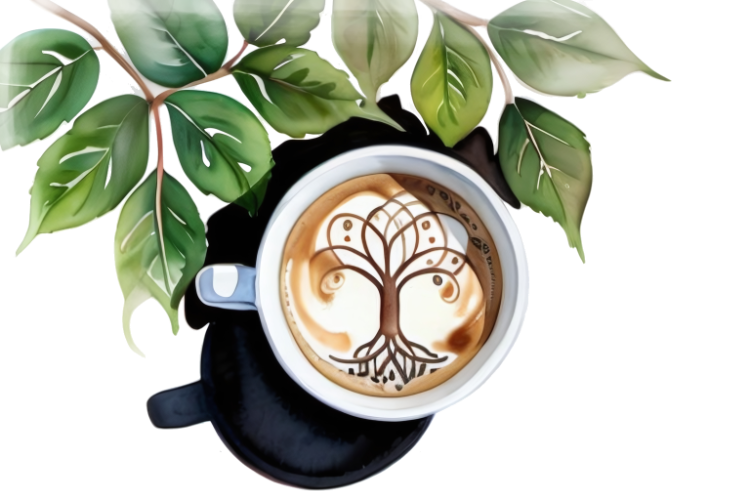
Roots take in water and nutrients from the soil, and release beneficial nutrients for other plants and creatures.
Trees use roots in concert with mycelial structures to communicate chemically and energetically with other trees.
Roots provide structure, grounding, and stability for the tree, for other nearby trees, the surrounding earth, and for creatures who live in and nearby the tree.

Coffee Inspiracy employs root imagery as symbols for the historical grounding of our stories, and our connections to our ancestors, families and neighbors.
The stem and branches provide passage. They are conduits for nutrients, sugars, water, and energy.
They also provide structure and support for leaves and fruit, and bring them to higher levels where they can gather light and air away from ground-based predators. This higher vantage provides an ideal height from which the cherries can drop and spread life.
The stem and branches provide a bridge between earth and sky.

They represent our movement as it manifests through this website, the services we provide, and our thinking, meditating, doing, being, talking, and sharing of these resources.
Leaves are trees' main organs of respiration. They take in carbon dioxide and light. Leaves use the energy of light to break down carbon dioxide and water, and reformulate them into carbon, oxygen and sucrose.
Carbon becomes the substance of the tree. Sucrose becomes the energy of the tree - the food of the cherry that will feed the seed. Oxygen released to the atmosphere from leaves is essential for all life on the planet.
The leaves of the coffee tree grow in a trefoil - a group of three.

Thus, for Coffee Inspiracy, the trefoil translates to people, ally, and intention.
Coffee cherries are the tree's expression of its potential, and the potential of life itself. They are both womb and child, potential and manifestation.
The fruit of the cherry provides food for growth. The seeds within are the beans we know as coffee. Born from the confluence of Earth, Air, Water, Fire and Spirit, they contain the heart of pure magic.

The icon we've chosen includes a single drop below, recalling both the tears of Waaqa and the essence of coffee expressed by the bean.


Inspiracy Manifesto
inspiracy | ɪnˈspɪrəsi |
noun (plural inspiracies)
An open and unrestricted plan by two or more people to inspire joy, peace, enthusiasm and hope for the future.
ORIGIN
Coined by Peter Moore, approximately 1993, as an antonym to "conspiracy", and an antidote to isolationism, separatism and, "us and them" thinking.
Coffee provides a gateway to an ally.
The coffee ally is morally and spiritually agnostic. Whatever you bring to the ally, it will magnify and return to you.
Through a collaborative and intentional relationship to the ally, we foster an entheogenic experience that engages our entire body, mind, and spirit.

Inspiracy
Manifesto
We shift the outcomes of these endeavors by transforming the nature and context of our relationship to the ally.
We transform our relationship to the coffee ally by intentionally choosing, crafting, and curating the set and setting of the relationship, and what we bring to it.

Inspiracy
Manifesto
We are inspired by ceremonies, celebrations and practices of all cultures and times that honor the ally, respect the plant, and foster human efforts to know the true peace that is the essence of our being.
That said, we are committed to authentically generating our work from our own experience, sourcing it within, from, and for our own culture, in this place, and this time.
We choose beauty, truth, love, inspiration, and curiosity as the basis for our work.
The primary symbol of Coffee Inspiracy incorporates a coffee tree in the form of a "tree of life" drawn as latté art in a mug nestled amongst the leaves and branches of a living coffee tree.
Many in Western culture will be familiar with the tree of life as a Celtic symbol of balance, harmony, and rebirth. But the tree of life appears in the symbology and mythology of many cultures, and carries myriad layers of meaning.
Coffee Inspiracy finds inspiration from each part of the coffee tree.

Roots take in water and nutrients from the soil, and release beneficial nutrients for other plants and creatures.
Trees use roots in concert with mycelial structures to communicate chemically and energetically with other trees.
Roots provide structure, grounding, and stability for the tree, for other nearby trees, the surrounding earth, and for creatures who live in and nearby the tree.

Coffee Inspiracy employs root imagery as symbols for the historical grounding of our stories, and our connections to our ancestors, families and neighbors.
The stem and branches provide passage. They are conduits for nutrients, sugars, water, and energy.
They also provide structure and support for leaves and fruit, and bring them to higher levels where they can gather light and air away from ground-based predators. This higher vantage provides an ideal height from which the cherries can drop and spread life.
The stem and branches provide a bridge between earth and sky.

They represent our movement as it manifests through this website, the services we provide, and our thinking, meditating, doing, being, talking, and sharing of these resources.
Leaves are trees' main organs of respiration. They take in carbon dioxide and light. Leaves use the energy of light to break down carbon dioxide and water, and reformulate them into carbon, oxygen and sucrose.
Carbon becomes the substance of the tree. Sucrose becomes the energy of the tree - the food of the cherry that will feed the seed. Oxygen released to the atmosphere from leaves is essential for all life on the planet.
The leaves of the coffee tree grow in a trefoil - a group of three.

Thus, for Coffee Inspiracy, the trefoil translates to people, ally, and intention.
Coffee cherries are the tree's expression of its potential, and the potential of life itself. They are both womb and child, potential and manifestation.
The fruit of the cherry provides food for growth. The seeds within are the beans we know as coffee. Born from the confluence of Earth, Air, Water, Fire and Spirit, they contain the heart of pure magic.

The icon we've chosen includes a single drop below, recalling both the tears of Waaqa and the essence of coffee expressed by the bean.



What's an Inspiriance?
I. An introduction to handmade espresso brewing and consumption.
II. A history of coffee mysticism, ceremony and ritual.
III. A guided entheogenerous meditation.
and
Participants
and
FAQs

Inspiriance Sessions
and
Participants
and
FAQs
Our brewing process intentionally engages the body, mind, and senses.

Inspiriance Sessions
and
Participants
and
FAQs

Inspiriance Sessions
and
Participants
and
FAQs

and
Participants
and
FAQs
Inspiriance Sessions

and
Participants
and
FAQs
Inspiriance Sessions
Sessions
and
FAQs

Locations
We recommend and request a quiet, private setting, free from distractions, conducive to focused attention and meditative introspection. Ideally, the place you choose for your session should be one where you find beauty and harmony.
Sessions
and
FAQs

Participants
Because of the care and time we allow for every espresso shot, we find that sessions with more than 2 participants can be problematically lengthy.
That said, we can provide for up to 4 participants if need be. See the price list for additional participant fees.
Participants must be at least 18 years old.
Sessions
and
Participants
Contact
and
FAQs

Sessions
and
Participants
Prices

Sessions
and
Participants
FAQs




and
Participants
and
FAQs
I. An introduction to handmade espresso brewing and consumption.
II. A history of coffee mysticism, ceremony and ritual.
III. A guided entheogenerous meditation.
What's an
Inspiriance?

and
Participants
and
FAQs
Our brewing process intentionally engages the body, mind, and senses.
Inspiriance
Sessions
and
Participants
and
FAQs

and
Participants
and
FAQs
Inspiriance
Sessions
and
Participants
and
FAQs

and
Participants
and
FAQs
Inspiriance
Sessions
and
Participants
and
FAQs

and
Participants
and
FAQs
Inspiriance
Sessions

and
Participants
and
FAQs
and
Participants
and
FAQs
Inspiriance
Sessions
Sessions
and
FAQs

We recommend and request a quiet, private setting, free from distractions, conducive to focused attention and meditative introspection. Ideally, the place you choose for your session should be one where you find beauty and harmony.
Locations
Sessions
and
FAQs

Because of the care and time we allow for every espresso shot, we find that sessions with more than 2 participants can be problematically lengthy.
That said, we can provide for up to 4 participants if need be. See the price list for additional participant fees.
Participants must be at least 18 years old.
Participants
and
Participants
Sessions
and
FAQs

Contact

and
Participants
Sessions
Prices

and
Participants
Sessions
